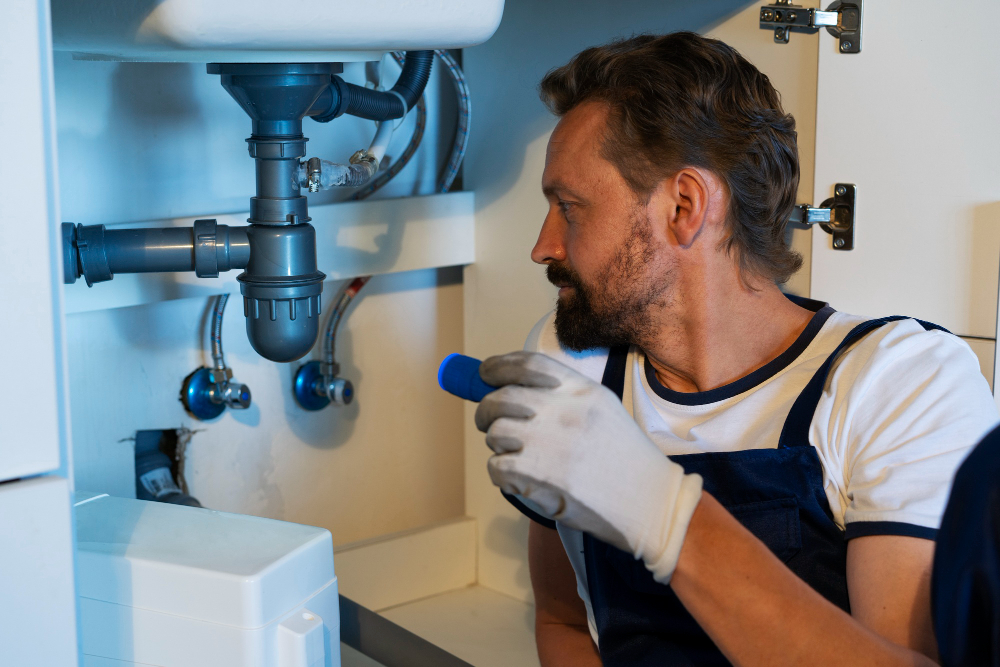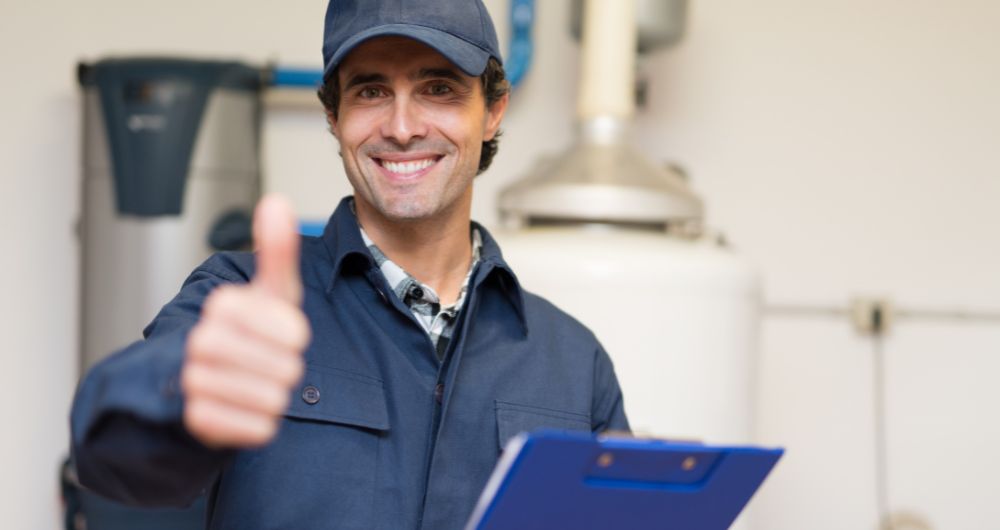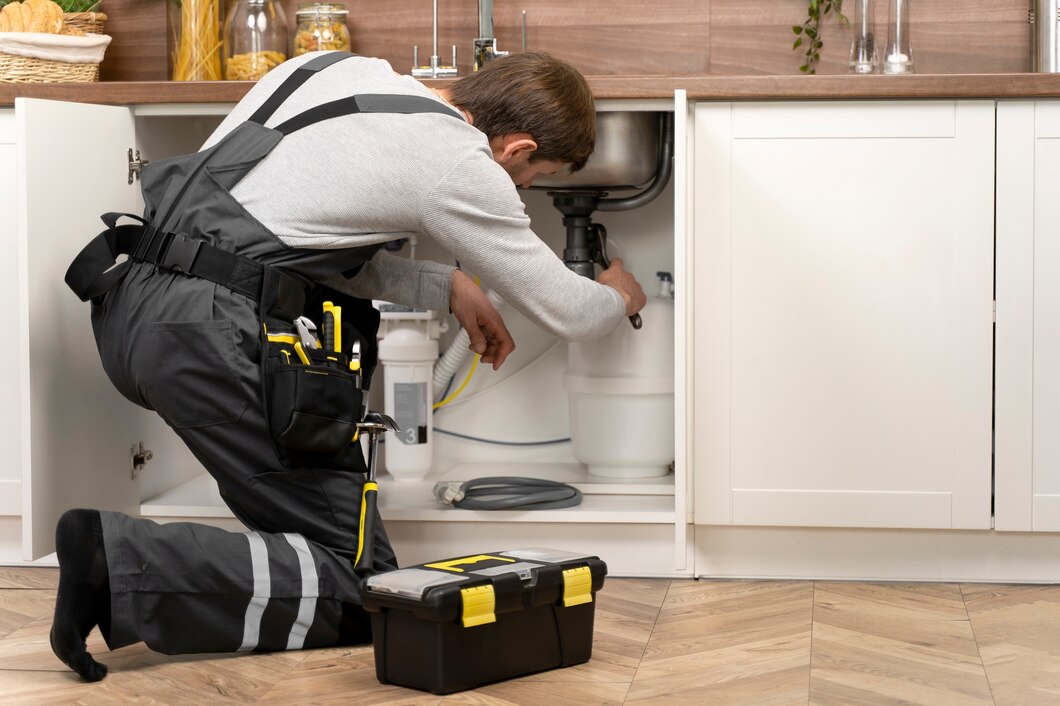Renovating a bathroom is an exciting yet complex task that requires careful planning and execution. One of the most critical aspects of a successful bathroom renovation is addressing the plumbing system. Without proper attention to plumbing, even the most beautifully designed bathroom can quickly turn into a nightmare of leaks, clogs, and inefficiency. Here, we will guide you through seven essential plumbing services in Torrington, CT, that you need to consider before renovating your bathroom.
Table of Contents
Key Takeaways
What to Consider Before Starting
7 Plumbing Services to Consider Before Renovating Your Bathroom
1. Plumbing Inspection and Assessment
2. Pipe Replacement or Upgrading
3. Drainage System Overhaul
4. Water Heater Evaluation
5. Fixture Upgrades and Installation
6. Installing New Plumbing Lines
7. Waterproofing and Leak Prevention
Post-Renovation Plumbing Checklist
Expert Tips for a Successful Bathroom Renovation
Frequently Asked Questions
Ready to Renovate Your Bathroom? Contact L&P Plumbing Today!
| Key Takeaways Identify and address existing issues through plumbing services before starting the renovation. Replace corroded or leaking pipes to ensure long-term reliability and performance. Adjust pipe slopes and install new drain pipes to prevent clogs and backups. Ensure the water heater can meet the demands of your renovated bathroom. Properly plan and professionally install new plumbing lines if relocating or adding fixtures. Implement thorough waterproofing and use leak detection systems to protect against water damage. |
What to Consider Before Starting
Before starting your bathroom renovation, it’s crucial to consider several key factors that will ensure a smooth and successful project, particularly regarding plumbing services.
Budgeting for Plumbing Services
Bathroom renovation costs typically range from $2,500 to $80,000, with most homeowners paying an average of around $10,978. While it might be tempting to cut costs on plumbing, investing in high-quality plumbing services will pay off in the long term by preventing future issues and repairs. Consider the following:
- Material Costs: The type of pipes and fixtures you choose can vary significantly in price. PVC pipes are generally more affordable, while copper pipes offer durability at a higher cost.
- Labor Costs: Hiring professional plumbing services ensures quality work but comes with labor costs. It’s crucial to budget for skilled labor to avoid shoddy work that could lead to future problems.
- Contingency Fund: Set aside a portion of your budget for unexpected issues that may arise during the renovation. This can help cover the cost of unforeseen plumbing repairs or upgrades.
Timeline
Incorporating plumbing services into your renovation timeline is crucial. Plumbing work often needs to be completed before other tasks, such as tiling or installing fixtures. Planning accordingly helps avoid delays and keeps the project on track.
- Pre-Construction Phase: Schedule an initial plumbing inspection and any necessary repairs before starting the main renovation work.
- Mid-Construction Phase: Ensure that new plumbing lines, fixtures, and systems are installed before completing wall and floor finishes.
- Post-Construction Phase: Conduct a final inspection and testing of all plumbing systems to ensure everything is functioning correctly before considering the project complete.
Choosing a Professional Plumber
Selecting a reputable and experienced plumbing service provider is vital. A professional plumber will ensure that all work is done to a high standard, adhering to local building codes. When choosing your plumbing services, consider the following:
- Experience and Qualifications: Verify that the plumber has experience with bathroom renovations and holds the necessary licenses and certifications.
- Customer Reviews: Read reviews and testimonials from previous clients to gauge the plumber’s reliability and quality of work.
- Detailed Estimates: Request detailed estimates that outline the scope of work, materials, and labor costs to avoid unexpected expenses.
7 Plumbing Services to Consider Before Renovating Your Bathroom

To ensure your bathroom renovation is both successful and hassle-free, it’s essential to address these eight crucial plumbing services before any work begins.
1. Plumbing Inspection and Assessment
A thorough plumbing inspection is the first step in any bathroom renovation. This assessment helps identify existing issues, such as leaks, corrosion, or outdated pipes, that need to be addressed before starting the renovation. An initial inspection ensures that all potential problems are identified and allows you to plan for necessary repairs or upgrades.
What to Look For
For plumbing services, focus on key areas such as the condition of pipes, water pressure, and any signs of leaks or damage. This information will guide the necessary plumbing upgrades and repairs. Key areas to inspect include:
- Pipes: Check for signs of corrosion, leaks, or damage in the pipes. Older pipes, especially galvanized steel pipes, are prone to rust and should be replaced.
- Water Pressure: Ensure that the water pressure is adequate for your bathroom needs. Low water pressure can indicate issues with the supply line or water heater.
- Drainage: Inspect the drainage system for clogs, slow drains, or backups. Proper drainage is essential to prevent water damage and maintain hygiene.
- Fixtures: Examine existing fixtures for wear and tear. Old or damaged fixtures may need to be replaced to ensure optimal performance.
Professional vs. DIY Inspection
While a DIY inspection can help identify obvious issues, getting professional plumbing services for a comprehensive assessment is recommended. Professionals have the expertise and tools to detect hidden problems that could impact your renovation. A professional inspection ensures that no detail is overlooked and provides a thorough evaluation of your plumbing system.
2. Pipe Replacement or Upgrading
When to Replace Pipes
Old, corroded, or leaking pipes should be replaced to prevent future issues. If your home has galvanized steel pipes, consider upgrading to modern materials like PVC or copper for improved durability and performance. Signs that indicate the need for pipe replacement include:
- Rust and Corrosion: Visible rust or corrosion on pipes is a clear sign that they need to be replaced.
- Leaks: Persistent leaks that cannot be easily repaired indicate that the pipes are worn out and should be replaced.
- Discolored Water: Brown or yellow water can be a sign of rust in the pipes, indicating the need for replacement.
- Low Water Pressure: Low water pressure can result from old, clogged, or corroded pipes that need to be upgraded.
Types of Pipes
PVC, copper, and PEX are popular choices for bathroom plumbing. Choose the material that best suits your needs and budget.
PVC
- Pros: Cost-effective, easy to install, resistant to corrosion.
- Cons: Not suitable for hot water pipes, can become brittle over time.
Copper
- Pros: Durable, reliable, resistant to bacteria, suitable for both hot and cold water.
- Cons: More expensive, requires professional installation, susceptible to corrosion in acidic water.
PEX
- Pros: Flexible, resistant to freezing, easy to install, suitable for both hot and cold water.
- Cons: Can be damaged by UV light, not as durable as copper.
Cost Considerations
The cost of pipe replacement varies based on the material, length, and complexity of the installation. Investing in high-quality pipes may have a higher upfront cost but will save money by reducing future maintenance and repairs. When budgeting for pipe replacement, consider the following:
- Material Costs: PVC is the most affordable option, while copper is the most expensive. PEX falls in the middle range.
- Labor Costs: Professional installation is recommended, which adds to the overall cost. The complexity of the job, such as working in tight spaces or dealing with existing infrastructure, can also affect labor costs.
- Long-Term Savings: Investing in high-quality pipes can reduce the frequency of repairs and increase the lifespan of your plumbing system, ultimately saving money in the long run.
3. Drainage System Overhaul
Common Drainage Issues
Slow drains and frequent clogs are common problems that can be exacerbated during a renovation. Addressing these issues beforehand ensures a smooth and efficient drainage system in your new bathroom. Common drainage issues include:
- Clogs: Hair, soap scum, and other debris can build up in drains, leading to clogs that restrict water flow.
- Slow Drains: Slow drainage can be caused by partial clogs, improper pipe slope, or venting issues.
- Backups: Sewer backups can occur when the main drain line is clogged, causing wastewater to back up into the bathroom.
Upgrading the Drainage System
Improving drainage involves adjusting pipe slopes, installing new drain pipes, and ensuring proper venting. These upgrades enhance the system’s efficiency and reduce the risk of clogs and backups. Steps to upgrade the drainage system include:
- Adjusting Pipe Slope: Ensure that drain pipes are installed with the correct slope to promote efficient water flow and prevent standing water.
- Installing New Drain Pipes: Replace old or damaged drain pipes with new ones made from durable materials like PVC.
- Adding Vent Pipes: Proper venting is essential for maintaining the pressure balance in the drainage system and preventing clogs and backups.
4. Water Heater Evaluation
Assessing Current Capacity
Determine if your existing water heater can meet the demands of your renovated bathroom, especially if you plan to add features like a spa tub or multiple shower heads. An undersized water heater may struggle to provide sufficient hot water, leading to discomfort and inefficiency. Factors to consider when assessing water heater capacity include:
- Number of Fixtures: More fixtures, such as multiple showerheads or a spa tub, require more hot water.
- Household Size: The number of people using the bathroom affects hot water demand.
- Water Heater Size: Ensure that the water heater has the appropriate capacity (measured in gallons) to meet your household’s hot water needs.
Installation Tips
Proper installation is crucial for water heater performance and safety. Ensure the unit is correctly sized, vented, and positioned to maximize efficiency and lifespan. Tips for installing a water heater include:
- Correct Sizing: Choose a water heater with the right capacity for your household’s hot water needs.
- Proper Venting: Ensure that the water heater is properly vented to prevent the buildup of harmful gases like carbon monoxide.
- Positioning: Install the water heater in a location that allows easy access for maintenance and reduces heat loss.
5. Fixture Upgrades and Installation
Choosing New Fixtures
Selecting the right fixtures enhances the functionality and aesthetics of your bathroom. Look for water-efficient models that blend style with sustainability.
- Style and Design: Choose fixtures that complement the overall design of your bathroom and meet your aesthetic preferences.
- Water Efficiency: Look for fixtures with WaterSense labels, which indicate that they meet EPA standards for water efficiency.
- Durability: Select fixtures made from high-quality materials that can withstand daily use and resist corrosion.
Installation Process
Installing new fixtures involves more than just swapping out old ones. Ensure proper alignment, sealing, and connection to avoid leaks and ensure optimal performance. Steps for installing fixtures include:
- Proper Alignment: Ensure that fixtures are correctly aligned with the plumbing lines to prevent leaks and ensure efficient water flow.
- Sealing: Use high-quality sealants to create watertight seals around fixtures and prevent leaks.
- Connection: Properly connect fixtures to the water supply and drainage lines to ensure they function correctly.
6. Installing New Plumbing Lines
When It’s Necessary
Installing new plumbing lines is necessary if you’re relocating fixtures or adding new ones. Proper planning ensures that all lines are correctly placed and meet code requirements. Situations that may require new plumbing lines include:
- Relocating Fixtures: Moving a toilet, sink, or shower to a new location requires new plumbing lines to be installed.
- Adding New Fixtures: Adding new features like a spa tub, additional showerhead, or bidet requires new plumbing connections.
- Upgrading Plumbing System: Replacing old, outdated plumbing lines with modern materials to improve efficiency and durability.
Professional Installation
Hiring professional plumbing services ensures that new plumbing lines are installed correctly and efficiently, minimizing the risk of leaks and ensuring long-term reliability. Benefits of professional installation include:
- Expertise: Professional plumbers have the knowledge and experience to install plumbing lines correctly and efficiently.
- Quality Workmanship: Professional installation ensures that all work is done to a high standard, reducing the risk of future issues.
- Code Compliance: Plumbing services ensure that all work meets local building codes and regulations.
7. Waterproofing and Leak Prevention
Importance of Waterproofing
Waterproofing is essential to prevent water damage and mold growth in your bathroom. Proper waterproofing extends the lifespan of your renovation and maintains a healthy environment. Areas that require waterproofing include:
- Shower and Tub Areas: These areas are exposed to the most water and require thorough waterproofing to prevent leaks.
- Floors and Walls: Waterproofing floors and walls, especially those near water sources, prevents water damage and mold growth.
- Seams and Joints: Properly sealing seams and joints between tiles, fixtures, and walls prevents water from seeping into hidden areas.
Leak Detection Systems
Modern leak detection systems provide an added layer of protection by alerting you to leaks early, allowing for prompt repairs and preventing extensive damage. Benefits of leak detection systems include:
- Early Detection: Detect leaks early before they cause significant damage.
- Automatic Shutoff: Some systems automatically shut off the water supply when a leak is detected, preventing further damage.
- Remote Monitoring: Many systems offer remote monitoring and alerts, allowing you to monitor your plumbing system from anywhere.
Post-Renovation Plumbing Checklist
After completing your bathroom renovation, it’s important to go through this post-renovation plumbing checklist to ensure that everything is functioning correctly and meets the highest standards of quality and safety.
Final Inspection
A final inspection verifies that all plumbing work is completed correctly and meets standards. This step ensures that no issues were overlooked during the renovation.
- Visual Inspection: Check all plumbing fixtures, pipes, and fittings for visible signs of leaks or damage.
- Pressure Testing: Test the water pressure to ensure it meets acceptable levels.
- Leak Detection: Use leak detection tools to check for hidden leaks in the plumbing system.
Testing New Fixtures and Systems
Testing new fixtures and plumbing systems ensures they function as intended. This includes checking for leaks, proper water pressure, and efficient drainage.
- Running Water: Turn on all faucets and fixtures to check for proper water flow and pressure.
- Drain Testing: Ensure that all drains are functioning correctly and water flows smoothly without any clogs.
- Water Heater Testing: Test the water heater to ensure it provides hot water consistently and efficiently.
Maintenance Tips
Regular maintenance is essential to keep your new bathroom in top condition. This includes routine checks for leaks, cleaning drains, and scheduling professional plumbing services for periodic inspections.
- Routine Inspections: Regularly inspect pipes, fixtures, and fittings for signs of wear or leaks.
- Drain Cleaning: Clean drains regularly to prevent clogs and maintain efficient drainage.
- Professional Maintenance: Schedule periodic inspections and maintenance with professional plumbing services to ensure optimal performance.
Expert Tips for a Successful Bathroom Renovation
To achieve the best results in your bathroom renovation, consider these expert tips that cover essential aspects like collaboration, budgeting, and ensuring quality work throughout the project.
Collaborate with Contractors
Clear communication helps avoid misunderstandings and ensures that all aspects of the project are aligned.
- Clear Communication: Maintain open and clear communication with all contractors and plumbers involved in the renovation.
- Detailed Contracts: Use detailed contracts that outline the scope of work, timeline, and payment terms.
- Regular Updates: Schedule regular updates and meetings to discuss progress and address any issues that arise.
Stay Within Budget
Managing costs is crucial to avoid overspending. Prioritize essential plumbing services and allocate your budget accordingly to ensure you stay within your financial limits.
- Detailed Budgeting: Create a detailed budget that includes all expected costs, including materials, labor, and permits.
- Contingency Fund: Set aside a contingency fund for unexpected expenses that may arise during the renovation.
- Prioritize Needs: Focus on essential plumbing services and upgrades that are necessary for the renovation.
Ensure Quality Work
Investing in quality plumbing services ensures that all work is done to a high standard. This not only enhances the functionality of your bathroom but also adds value to your home.
- Hiring Professionals: Hire experienced and reputable plumbing services to ensure quality workmanship.
- Quality Materials: Use high-quality materials for pipes, fixtures, and fittings to ensure durability and performance.
- Inspections: Conduct thorough inspections at key stages of the renovation to ensure all work meets quality standards.
Frequently Asked Questions
How many days should it take to remodel a bathroom?
Remodeling a bathroom typically takes 2-3 weeks, depending on the project’s complexity and the availability of materials and labor.
What is the best time of year to remodel a bathroom?
Spring and summer are ideal for bathroom remodels due to longer daylight hours and better weather, making it easier to schedule and complete work.
Should I clean before the plumber comes?
Yes, cleaning the area where the plumber will work helps them access pipes and fixtures more easily and ensures a smoother, quicker service.
What to do before calling for plumbing services?
Identify the issue, gather any necessary information about your plumbing system, and check for warranties or insurance coverage. This helps provide the plumber with essential details.
Do you plumb or tile first?
Plumb first, then tile. Plumbing work should be completed before installing tiles to ensure all pipes and fixtures are properly placed and secured.
Ready to Renovate Your Bathroom? Contact L&P Plumbing Today!

If you’re planning a bathroom renovation in Torrington, CT, make sure you have the best plumbing services on your side. L&P Plumbing in Torrington, CT, offers expert services to ensure your project is a success from start to finish. Our experienced professionals are ready to handle all your plumbing needs, from inspections to installations.
Contact L&P Plumbing today for a consultation. Call us now or visit our website to schedule your appointment!

